While the vast majority of Android apps are written in Java, there's no rule that you have to use Java for Android development. There are a variety of modern programming languages that are designed to run on the Java Virtual Machine (JVM), and one of these languages that's becoming popular in the Java community is Kotlin.
In the first part of this three-part series, we looked at what Kotlin is and what it has to offer Android developers:
- It's 100% interchangeable with Java, to the point where you can continue to use existing Java libraries and frameworks, and can even use a mixture of Java and Kotlin code in your Android projects.
- Its syntax is designed to feel very similar to Java, meaning it should be fairly easy for Java developers to get to grips with the fundamentals of Kotlin.
- It combines features and concepts from both functional and procedural programming.
- It's well-supported by Android Studio.
In this follow-up tutorial, we're going to get started with some actual Kotlin development. By the time you reach the end of the tutorial, you’ll have created a simple Android app that displays a line of text—and is written entirely in Kotlin. You’ll also know how to avoid ever having to write another findViewById, by making use of Kotlin’s Android extensions.
But first, it's time to teach our development environment how to speak a new language!
Installing the Kotlin Plugin in Android Studio
The very first thing you need to do is add Kotlin support to your Android Studio installation.
Before we get started, make sure you’re running the most recent, stable version of Android Studio, as you’re more likely to encounter bugs with the Kotlin plugin on experimental versions of Android Studio. It’s also worth opening the SDK Manager and checking whether updates are available for any of the packages you’ve installed.
Once you’re confident that your development environment is up to date, you're ready to install the Kotlin plugin. Launch Android Studio and you should see the Welcome to Android Studio window—if this window doesn’t appear, then close Android Studio completely and relaunch it.
Give the Configure icon a click, and then select Plugins from the subsequent dropdown.
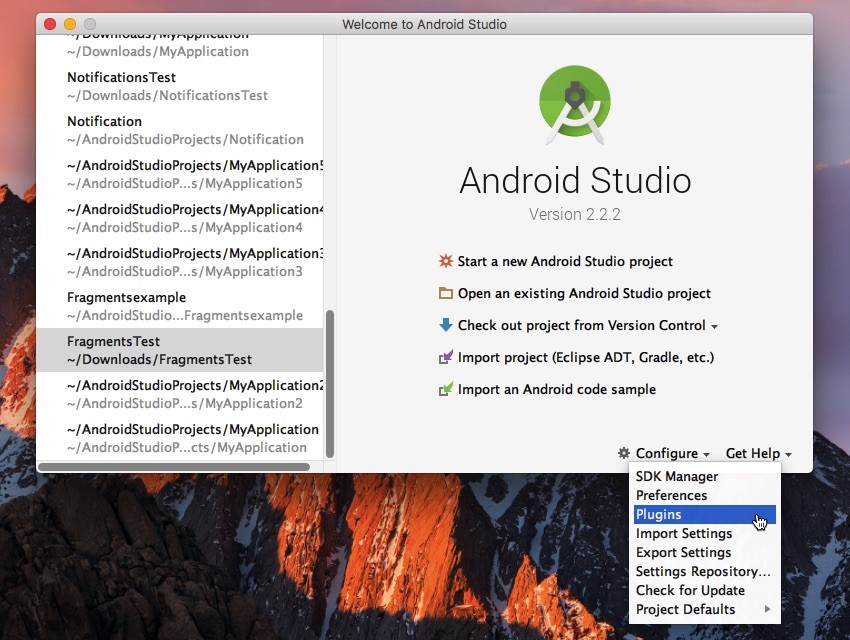
Click the Install JetBrains plugins... button.
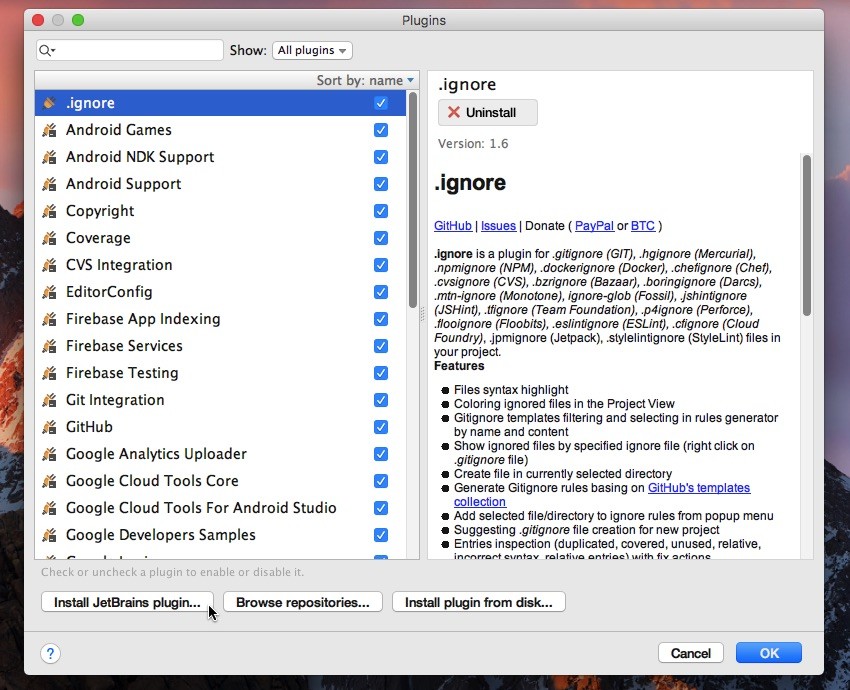
Select Kotlin from the menu, and then click the green Install button. You’ll need to restart your IDE before the Kotlin plugin becomes active, so either click the Restart Android Studio button that appears or restart your IDE manually.
Configuring Your Project to Use Kotlin
At this point, your IDE can understand and run Kotlin code, but you’ll still need to configure Kotlin every time you want to use it in a new project. Let’s create a new project and configure that project to use Kotlin now. Create a new project with the settings of your choice, but for the sake of simplicity, select Empty Activity when prompted.
Thanks to the Kotlin plugin, configuring a project to use Kotlin couldn’t be simpler: just select Tools from the Android Studio toolbar, followed by Kotlin and Configure Kotlin in Project.
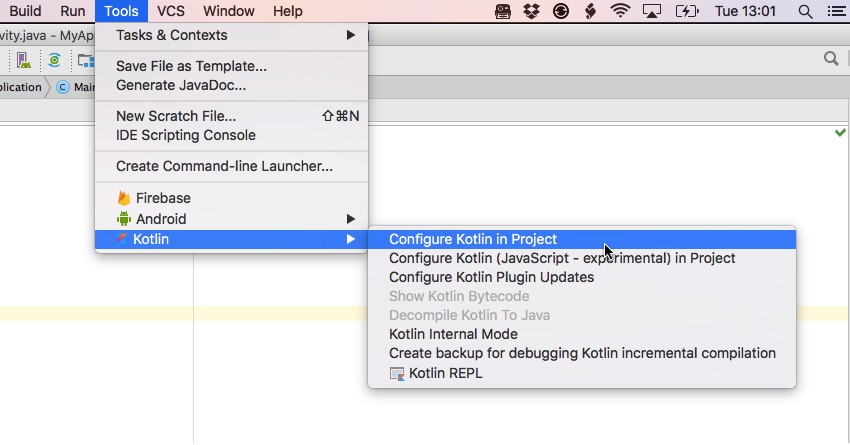
This opens a popup where you can choose to configure Kotlin for:
- all modules
- all modules containing Kotlin files
- or a single, named module
Since I’m only going to use Kotlin code in my project, I opted for All modules. You can also choose which version of Kotlin you want to use—typically, this will be the latest version.
Alternatively, you can configure Kotlin by selecting Help from the Android Studio menu bar, followed by Find Action… In the Find Action bar, start typing Configure Kotlin in Project, and then select this option when it appears.
The Configure Kotlin in Project option makes a number of tweaks to your project’s build.gradle files, so let’s take a closer look at how these files have changed. Open your project-level build.gradle file—it should look something like this:
buildscript {
//Declares the version of Kotlin that you’re using. You’ll notice that the version of Kotlin is mentioned in both the buildscript classpath and in your project’s compile dependencies - the version number must be the same in both places//
ext.kotlin_version = '1.0.5-2'
repositories {
jcenter()
}
dependencies {
classpath 'com.android.tools.build:gradle:2.2.2'
//Declares the Kotlin Gradle plugin as a classpath dependency//
classpath "org.jetbrains.kotlin:kotlin-gradle-plugin:$kotlin_version"
}
}
allprojects {
repositories {
jcenter()
}
}
Now, let’s take a look at your module-level build.gradle file:
apply plugin: 'com.android.application'
//Applies the Kotlin Android plugin//
apply plugin: 'kotlin-android'
android {
compileSdkVersion 25
buildToolsVersion "24.0.0"
defaultConfig {
applicationId "com.jessicathornsby.kotlinexample"
minSdkVersion 21
targetSdkVersion 25
versionCode 1
versionName "1.0"
}
buildTypes {
release {
minifyEnabled false
proguardFiles getDefaultProguardFile('proguard-android.txt'), 'proguard-rules.pro'
}
}
//Although Gradle will compile any Kotlin files it finds in src/main/java, it’s good practice to store your Kotlin files in a dedicated Kotlin directory. Here, you can see that the Kotlin plugin has added a src/main/kotlin declaration to build.gradle, but note that it hasn’t actually created this directory, so we’ll create it ourselves later in this article//
sourceSets {
main.java.srcDirs += 'src/main/kotlin'
}
}
dependencies {
compile fileTree(dir: 'libs', include: ['*.jar'])
androidTestCompile('com.android.support.test.espresso:espresso-core:2.2.2', {
exclude group: 'com.android.support', module: 'support-annotations'
})
compile 'com.android.support:appcompat-v7:25.0.1'
testCompile 'junit:junit:4.12'
//Adds the Kotlin Standard Library as a project dependency//
compile "org.jetbrains.kotlin:kotlin-stdlib:$kotlin_version"
}
repositories {
mavenCentral()
}
Finally, sync your changes either by clicking Sync Now from the popup that appears or by clicking the Sync Project with Gradle Files icon in Android Studio’s toolbar.
Convert Any Java File to Kotlin
One feature of the Kotlin plugin that’s particularly useful for Kotlin newcomers is its ability to convert any Java source file to Kotlin, while maintaining full runtime compatibility.
Being able to see exactly how any Java file would translate into Kotlin is ideal for helping you learn the language, but it can also come in useful throughout your Kotlin journey—if you’re ever struggling to work out how to write something in Kotlin, you can always write it in Java and then use this feature to convert that code into Kotlin.
Let’s convert our project’s MainActivity file into a Kotlin source file. There are two ways of invoking the Kotlin plugin’s Convert Java File to Kotlin File action, so either:
Select your MainActivity file, and then select Code from Android Studio’s menu bar, followed by Convert Java File to Kotlin File.
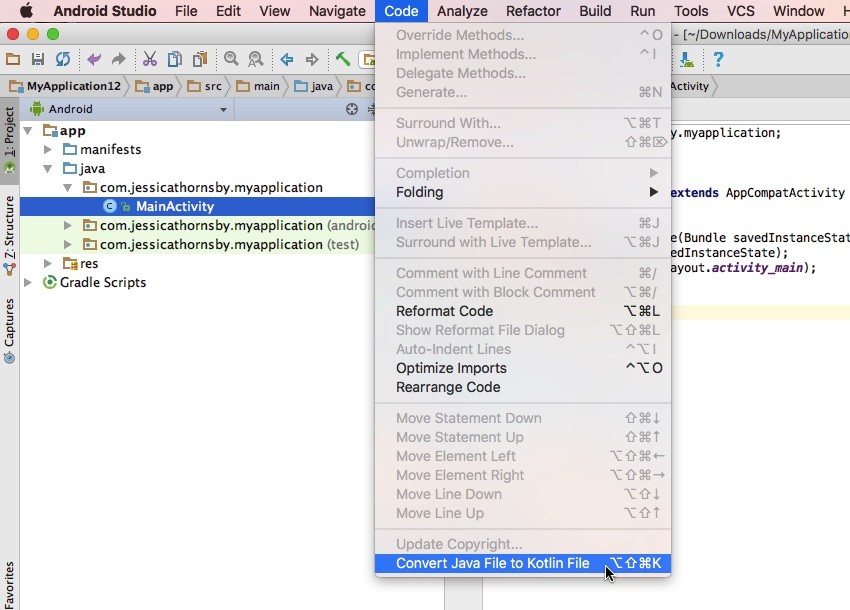
Or select Help from the Android Studio menu bar, followed by Find Action. In the subsequent popup, start typing Convert Java file to Kotlin file and then select this option when it appears. Note, you can also launch the Find Action popup with a keyboard shortcut: if you’re on a Mac, press the Command-Shift-A keys, and if you’re on Windows or Linux then press Control-Shift-A.
Just be aware that, depending on the complexity of your code, the conversion may not always be 100% accurate, so you should always check your converted code for errors.
Your newly-converted MainActivity should look something like this:
import android.support.v7.app.AppCompatActivity
import android.os.Bundle
class MainActivity : AppCompatActivity() {
override fun onCreate(savedInstanceState: Bundle?) {
super.onCreate(savedInstanceState)
setContentView(R.layout.activity_main)
}
}
You’ll also notice that the file’s extension has changed, transforming from MainActivity.java to MainActivity.kt.
This may be a simple Activity, but these few lines illustrate some key characteristics of the Kotlin syntax. Since this is our first look at some actual Kotlin code, let’s pick this class apart line by line.
Understanding Kotlin Syntax
In Kotlin, you declare classes using the keyword class, exactly like in Java. However, in Kotlin, classes (and methods) are public and final by default, so you can create a class simply by writing class MainActivity.
When it comes to extending a class, you replace Java’s extends with a colon, and then attach the name of the parent class. So in the first line of our MainActivity.kt file, we’re creating a public, final class called MainActivity that extends AppCompatActivity:
class MainActivity : AppCompatActivity() {
The Java equivalent would be:
public class MainActivity extends AppCompatActivity {
If you do want to override a class or method, then you’ll need to explicitly declare it as open or abstract.
In Kotlin, functions are defined using the fun keyword, followed by the function name and the parameters in brackets. In Kotlin, the function’s name comes before its type:
override fun onCreate(savedInstanceState: Bundle?) {
This is the opposite of Java, where type comes before name:
public void onCreate(Bundle savedInstanceState)
Note that we’re not specifying that this method is final, as in Kotlin all methods are final by default.
The rest of this Activity looks pretty similar to Java. However, these few lines do illustrate another key characteristic of Kotlin:
super.onCreate(savedInstanceState) setContentView(R.layout.activity_main)
In Kotlin you don’t need to finish your lines with semicolons, hence the absence of colons in the above snippet. You can add colons if you really want to, but your code will be cleaner and easier to read without them.
Now that we’ve deciphered our MainActivity.kt file, let’s move it to its proper home. Since the Kotlin plugin went to the trouble of adding a src/main/kotlin declaration to our build.gradle file, let’s actually create this directory. This step isn’t mandatory, but keeping your Kotlin files in a dedicated directory will make for a much cleaner project.
In Android Studio’s Project Explorer, Control-click your project’s Main directory and select New from the menu that appears, followed by Directory. Name this directory kotlin and then click OK.

If you’re struggling to spot your project’s main directory, then open the little dropdown in the upper-left of the Project Explorer and select Project. You should now have no problems spotting that elusive src/main directory.
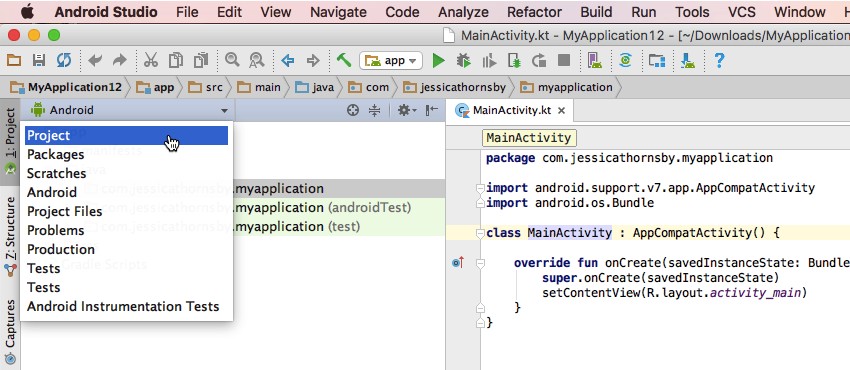
Once you’ve created a dedicated Kotlin directory, drag your MainActivity.kt file into it. Just be sure to retain your MainActivity.kt file’s existing package name so that your project still runs.
Also, if you’re only going to use Kotlin in this project, then you may want to delete the Java directory, rather than cluttering up your project with empty and unnecessary directories.
Since Kotlin compiles to bytecode, an application that’s written in Kotlin feels exactly the same as an application that’s written in Java, so try installing this app on your Android device or a compatible AVD—it should feel as if nothing has changed.
Creating Extra Kotlin Files
If you continue working with Kotlin in your project, then sooner or later you’re going to need to start creating new Kotlin files rather than simply converting existing Java ones.
To create a Kotlin file, Control-click your app/src/main/kotlin directory and select New > Kotlin Activity.
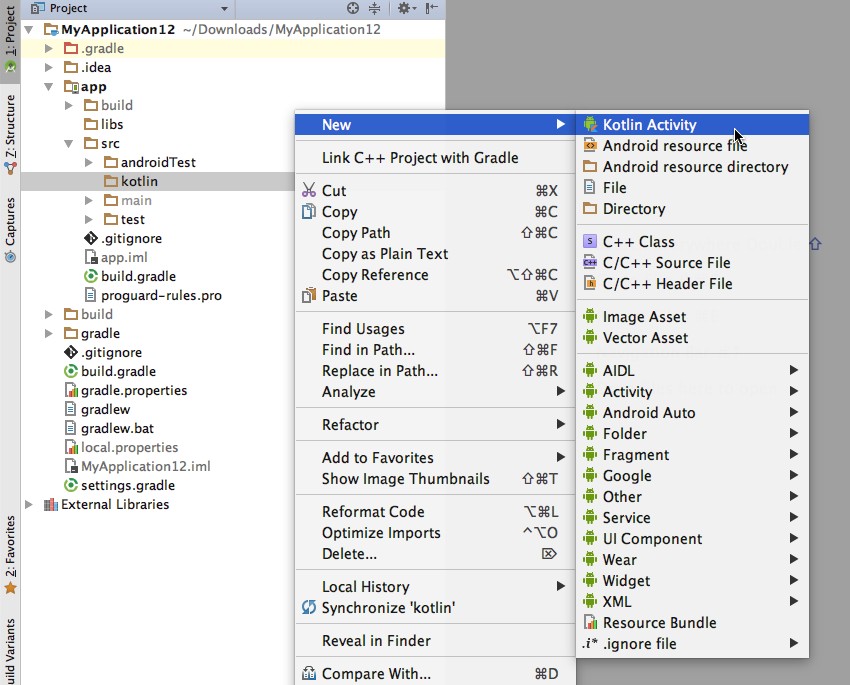
Give your class a name and select class from the dropdown menu. Your new class should look something like this:
class SecondActivity {
}
At this point, your Activity is empty. To get to the point where you can start adding some real functionality, you’ll need to complete a few steps. Firstly, add the import statements you want to use. The only difference between import statements in Kotlin and import statements in Java is that you don’t need to finish each line with a semicolon. For example:
import android.app.Activity import android.os.Bundle import android.app.Activity
You’ll then need to specify the class you’re extending, using the same format we saw in our MainActivity.kt file:
class SecondActivity : Activity() {
}
Next, you need to override the Activity’s onCreate method:
override fun onCreate(savedInstanceState: Bundle?) {
super.onCreate(savedInstanceState)
}
You can now add whatever functionality you want to this Activity (and in the next section, I’ll show you how to use Kotlin extensions to manipulate UI widgets, so this may be a good place to start), but one last bit of setup you need to complete is declaring your Kotlin Activity in your Manifest. This follows exactly the same formula as declaring a new Java Activity, for example:
<activity
android:name=".SecondActivity"
android:label="@string/second"
android:parentActivityName=".MainActivity">
<meta-data
android:name="android.support.PARENT_ACTIVITY"
android:value=".MainActivity"/>
</activity>
Kotlin Android Extensions: Wave Goodbye to findViewById
Now that we’ve mastered the basics, let’s take a closer look at what Kotlin is really capable of—starting with a feature that can really cut the amount of boilerplate code you need to write.
In Android, every time you want to work with any View in an Activity, you need to use the findViewById method to obtain a reference to that View. This makes findViewById one of the most important, but also one of the most frustrating bits of code that you’ll find yourself writing over and over, and over again in your Android projects. The findViewById method is a huge source of potential bugs, and if you’re working with multiple UI elements in the same Activity, then all those findViewByIds can really clutter up your code, making it difficult to read.
While there are a number of libraries, such as Butter Knife, that aim to remove the need for findViewByIds, these libraries still require you to annotate the fields for each View, which can lead to mistakes and still feels like a lot of effort that would be better invested in other areas of your project.
The Kotlin Android Extensions plugin (which has recently been incorporated into the standard Kotlin plugin) promises to make findViewById a thing of the past, offering you the benefits of the aforementioned libraries without the drawback of having to write any additional code or ship an additional runtime.
You can use Kotlin extensions to import View references into your source files. At this point the Kotlin plugin will create a set of “synthetic properties” that enable you to work with these views as though they were part of your activity—crucially, this means you no longer have to use findViewById to locate each View before you can work with it.
To use extensions, you’ll need to enable the Kotlin Android Extensions plugin in each module, so open your module-level build.gradle file and add the following:
apply plugin: 'kotlin-android-extensions'
Sync these changes by clicking the Sync Now popup.
You can then import the references to a single View, using the following format:
import kotlinx.android.synthetic.main.<layout>.<view-id>
For example, if your acitivity_main.xml file contained a TextView with the ID textView1, then you’d import the reference to this view by adding the following to your Activity:
import kotlinx.android.synthetic.main.activity_main.textView1
You’d then be able to access textView1 within this activity using its ID alone—and without a findViewById in sight!
Let’s take a look at extensions in action, by adding a TextView to our activity_main.xml file, importing it into our MainActivity.kt file, and using extensions to set the TextView’s text programmatically.
Start by creating your TextView:
<?xml version="1.0" encoding="utf-8"?>
<RelativeLayout xmlns:android="http://schemas.android.com/apk/res/android"
xmlns:tools="http://schemas.android.com/tools"
android:id="@+id/activity_main"
android:layout_width="match_parent"
android:layout_height="match_parent"
android:paddingBottom="@dimen/activity_vertical_margin"
android:paddingLeft="@dimen/activity_horizontal_margin"
android:paddingRight="@dimen/activity_horizontal_margin"
android:paddingTop="@dimen/activity_vertical_margin"
tools:context="com.jessicathornsby.myapplication.MainActivity">
<TextView
android:id="@+id/myTextView"
android:layout_width="wrap_content"
android:layout_height="wrap_content"
/>
</RelativeLayout>
You can then import the TextView into your MainActivity.kt, and set its text using its ID only:
import android.support.v7.app.AppCompatActivity
import android.os.Bundle
import kotlinx.android.synthetic.main.activity_main.myTextView
class MainActivity : AppCompatActivity() {
override fun onCreate(savedInstanceState: Bundle?) {
super.onCreate(savedInstanceState)
setContentView(R.layout.activity_main)
myTextView.setText("Hello World")
}
}
Note, if you want to work with multiple widgets from the same layout file, then you can import the entire contents of a layout file in one fell swoop, using the following formula:
import kotlinx.android.synthetic.main.<layout>.*
For example, if you wanted to import all the widgets from your activity_main.xml file, then you’d add the following to your Activity:
kotlinx.android.synthetic.main.activity_main.*.
Conclusion
In this second installment, we covered setting up your development environment to support Kotlin, and looked at how easy it is to convert your existing Java code into Kotlin. We also looked at some of the major characteristics of the Kotlin syntax, and introduced Kotlin Android extensions into our project.
In the third and final installment, we’ll look at some more advanced features of the Kotlin language that, as an Android developer, you should find especially useful.








Comments